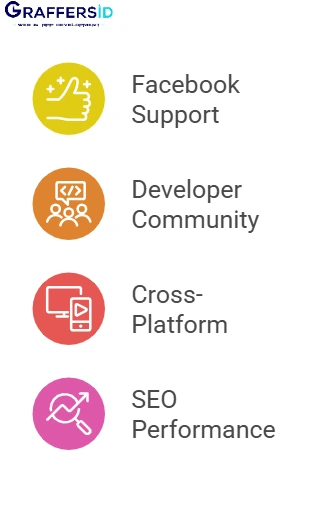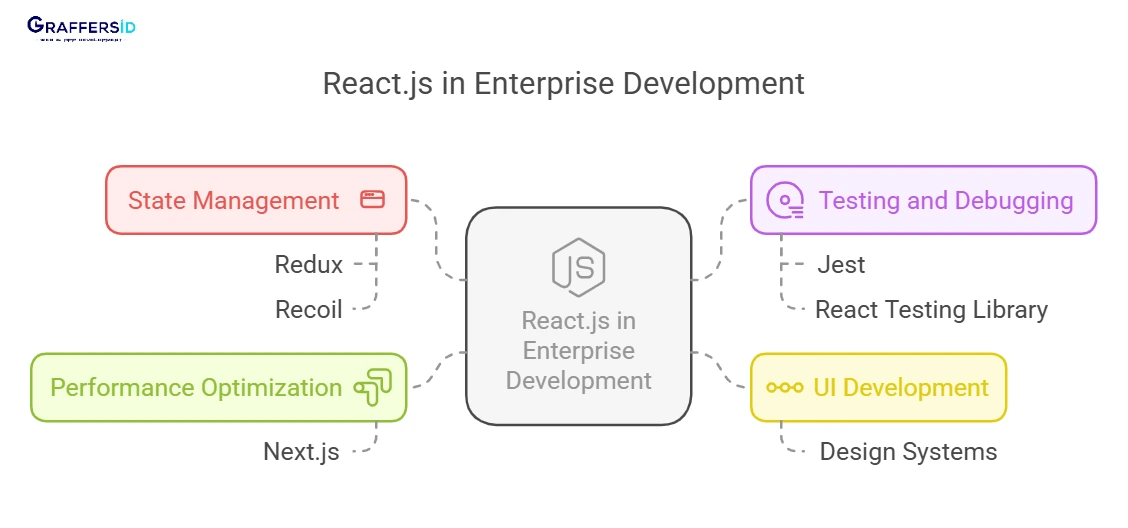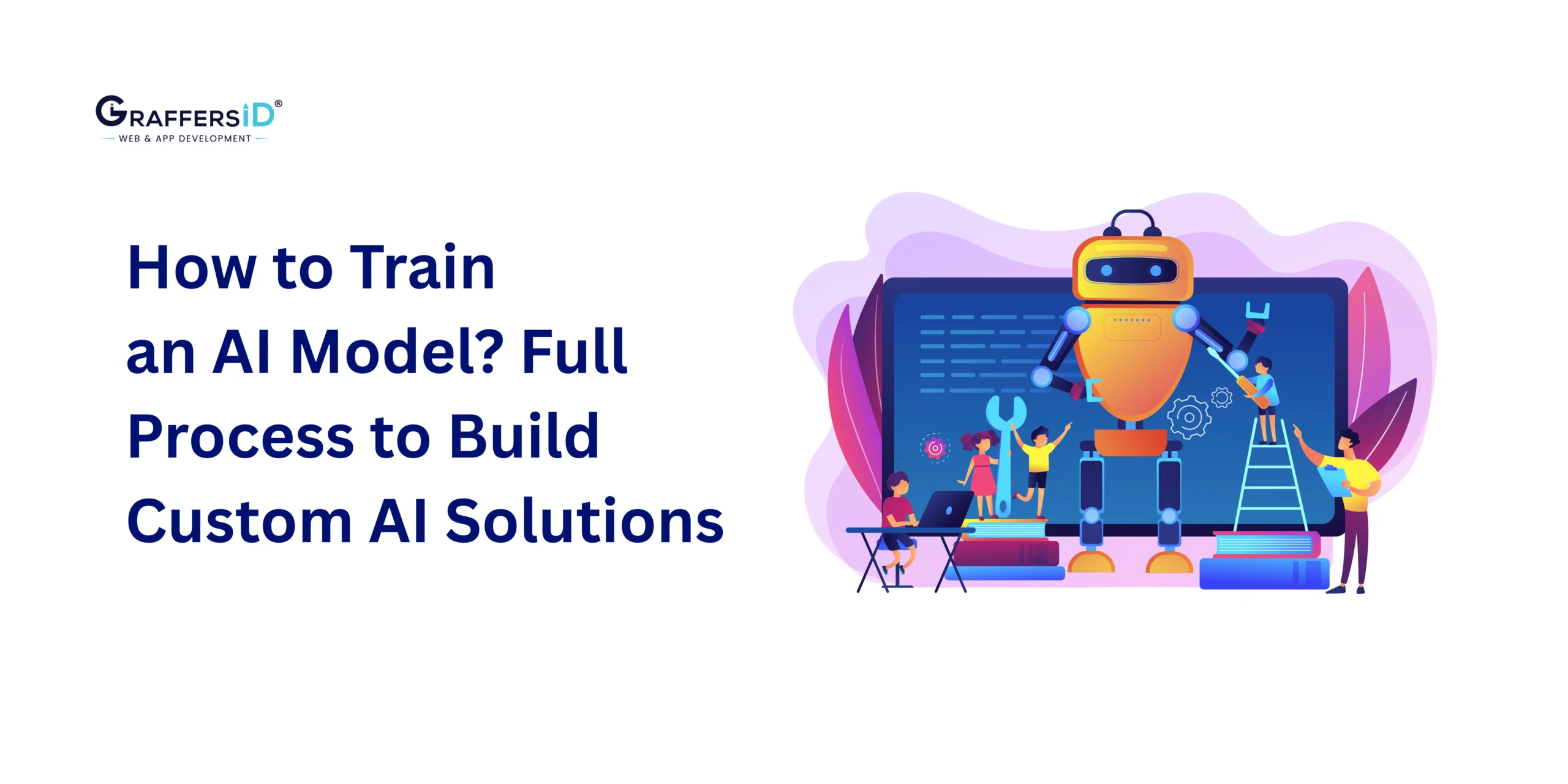Everyone wants to build robust, scalable, and maintainable solutions for their web applications to stay ahead in the digital landscape. For this purpose, react js has emerged as a popular choice mainly due to its performance, flexibility, and ecosystem support. React js, which was originally developed by Facebook, is a widely adopted frontend framework. It has been used to make several powerful enterprise applications like Airbnb, Uber, Netflix, and Instagram. In this article, we will look at how React js for enterprise applications is a strategic choice. With its, component reusability and ROI, the vast enterprise-ready ecosystem it offers, many companies leverage React js to build scalable applications and display great performance.
Why Enterprises Are Embracing React.js
There are several reasons why enterprises adopt React js for development, including-

1. Facebook Backing and Long-Term Support
Meta, previously known as Facebook, built React js to tackle its internal UI development challenges. From the time of its release, React js has been improved and developed continually with performance optimizations, concurrent rendering updates, and better state management solutions. Backed with Meta’s support, companies can instill there trust in React js to continue evolving and remain a future-proof solution for the coming years.
2. Massive Developer Community and Talent Pool
React js boasts massive support from the developer community, which is also one of the biggest advantages of using React js for enterprise applications. It has worldwide developer support. This means-
- Third-party libraries and extensive documentation along with faster problem resolution.
- Easy hiring of React.js developers with ready-made solutions for common challenges.
- Quick adaptability to new industry trends with regular feature updates.
3. Cross-Platform Consistency
This technology allows enterprises to maintain code consistency across web, mobile, and desktop applications. Developers can use React Native with React js architecture and build cross-platform mobile applications, reducing development time and costs.
4. SEO-Friendly Performance with Server-Side Rendering (SSR)
Enterprise applications of e-commerce, SaaS, and content-based platforms require strong search engine visibility. With React js, developers can seamlessly work with Next js, allowing server-side rendering (SSR) and statics site generation (SSG) which improves load speeds as well as SEO rankings.
With the benefits of React js, enterprises can build scalable, efficient, and future-ready applications which allows them stay relevant and meet the demands of modern digital platforms.
Component Reusability and ROI: How React.js Reduces Development Costs
When building software for enterprise-level operations, you need to ensure efficiency, maintainability, and scalability. React js provides component-based architecture which is one of its strongest suits. This significantly impacts ROI and cost-effectiveness.
1. Faster Development Cycles with Reusable Components
Components are modular and reusable across different parts of the application in React js. This has several benefits for enterprises-
- Accelerated development: Rather than writing everything from scratch, developers can reuse pre-built UI components.
- Consistency across applications: With React js, UI design remains consistent across different enterprise applications.
- Easier debugging: Isolated components make it simpler to test and fix issues without affecting the entire application.
2. Lower Maintenance Costs
With React js, you can cost-effectively maintain your enterprise applications as it minimizes long-term maintenance costs.
- Virtual DOM efficiency: You can ensure optimal rendering for complex UIs which ultimately reduces performance bottlenecks.
- Backward compatibility: With React js enterprises do not need to worry about rewriting their applications with every major release as updates in React are non-disruptive.
- Automated testing compatibility: React.js integrates smoothly with testing frameworks such as Jest, Mocha, and Cypress, enabling companies to adopt continuous integration and continuous deployment (CI/CD) practices.
3. Scalability and Future-Proofing
React.js is built to scale alongside growing applications, making it a great choice for enterprise projects that serve millions of users. Some key features include:
- Code-splitting and lazy loading, enhance performance by only loading the components that are needed.
- State management options such as Redux, Recoil, and the Context API facilitate effective data management in large applications.
- Microfrontend architecture allows teams to work on, deploy, and update various parts of an application independently.
Enterprise-Ready Ecosystem: Tools and Libraries for Large-Scale Development
Enterprises need a tech stack that can support scalability, flexibility, and wel-supported tools to manage their applications. With React js, you can have a rich ecosystem that will support state management, testing, UI development, and performance optimization.

1. State Management with Redux and Recoil
Handling global state in enterprise applications is challenging. React.js offers several state management solutions, including:
- Redux: Best for managing large-scale applications where multiple components rely on shared data.
- Recoil: A more lightweight alternative to Redux with built-in atomic state management, making it ideal for performance-intensive apps.
- Context API: Suitable for smaller projects that don’t require an external state management library.
2. Testing and Debugging with Jest and React Testing Library
Enterprises need robust testing strategies to prevent failures in production. React.js integrates seamlessly with:
- Jest: A widely-used testing framework optimized for React applications.
- React Testing Library: Focuses on user interactions, making tests more reliable and readable.
- Cypress: Great for end-to-end testing in large applications.
3. UI Development and Design Systems
Maintaining brand consistency across different products is crucial for enterprises. React.js supports:
- Material-UI and Chakra UI: Pre-built component libraries for rapid development.
- Storybook: A powerful tool to develop and test UI components in isolation.
- Tailwind CSS: A utility-first CSS framework that enables highly customizable and scalable UI development.
4. Performance Optimization with Next.js
React.js applications become even more powerful when paired with Next.js, which enables:
- Server-side rendering (SSR) for SEO optimization.
- Static site generation (SSG) to improve load speeds.
- API routes to handle backend functionality without a dedicated server.
This extensive React.js ecosystem allows enterprises to integrate best-in-class tools, frameworks, and libraries to build and scale applications with efficiency and precision.
Case Studies: How Enterprises Are Using React.js for Large-Scale Applications
1. Airbnb – Interactive and Dynamic UI
Airbnb- a popular homestay platform- uses React js to build an intuitive and highly interactive booking experience for its customers. Several features like real-time filtering, instant updates, and seamless animations make the application attractive and user-friendly.
2. Uber – Scalable Web Applications
Uber- a transportation service provider- leverages React js for several internal and external tools. Their driver dashboard and ride-tracking UI are very useful for users of the applications. React’s component-based structure allows Uber to bring out new features without breaking existing functionality.
3. Netflix – Optimized Performance with React.js
The popular streaming platform has employed React js because of its server-side rendering capabilities, which significantly reduced initial load times. This has improved the streaming experience of millions of users on low-bandwidth networks.
4. Instagram – Seamless User Experience
Everyones favorite past-time- Instagram-uses React js for features like real-time post updates along with infinite scrolling, and dynamic notifications. These features have significantly enhanced the user-experience and made it more engaging.
Conclusion
If you want to build scalable digital products that provide unmatched flexibility, performance, and cost-efficiency, you should choose React js. Its component-based architecture, rich ecosystem, and real-world adoption by industry giants makes React js the go-to choice for large-scale applications. By adopting this technology, businesses can ensure faster development, improved maintainability, and seamless scalability.
If you are looking to leverage React js for enterprise applications and need to hire skilled developers for development, you can contact us. At GraffersID, we make it our mission to bring your vision to life and make the entire development cycle a seamless process.





